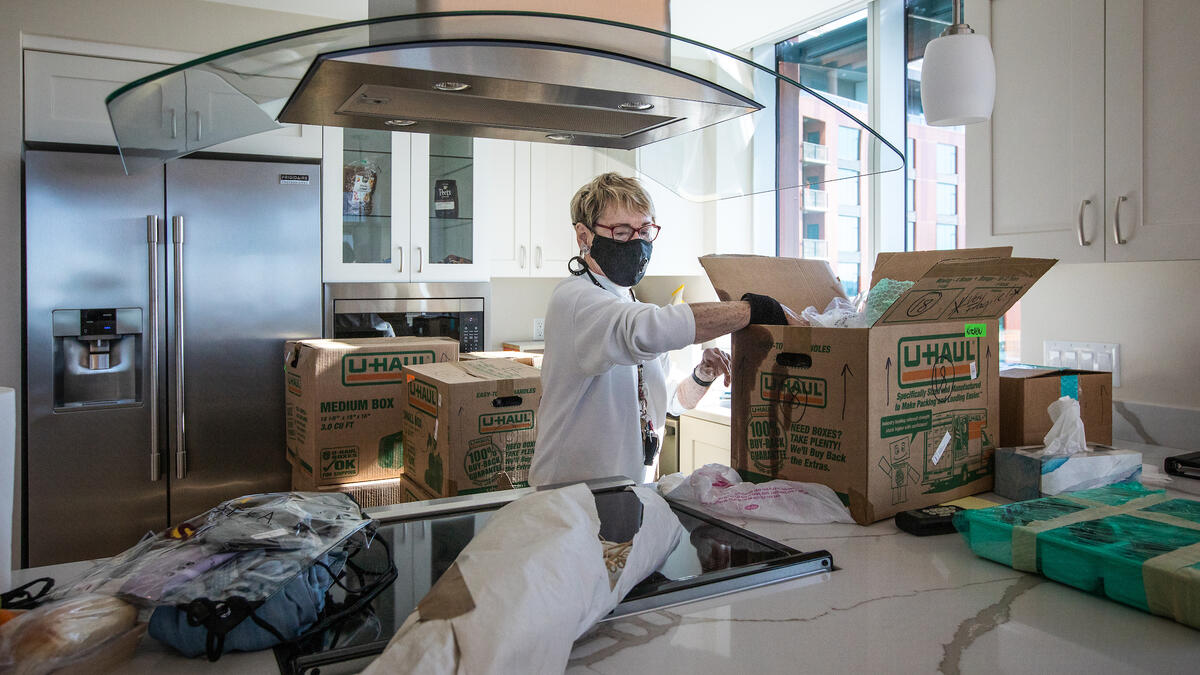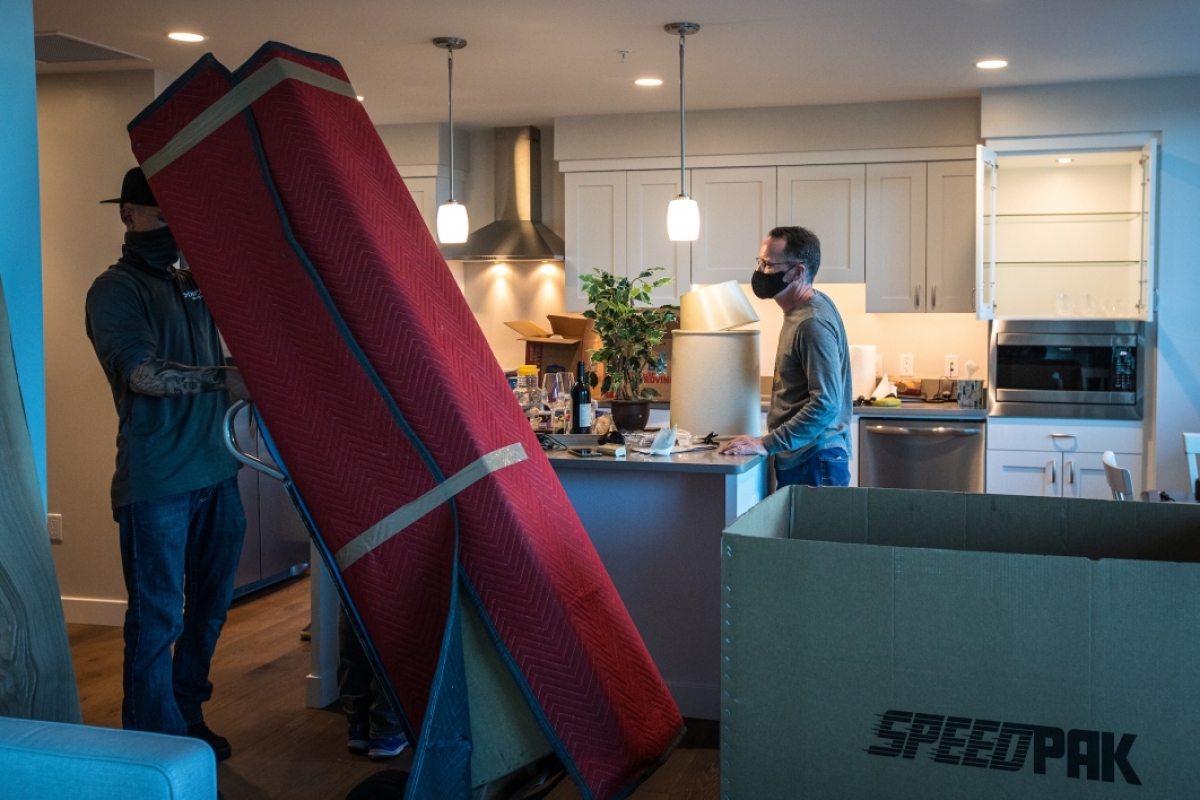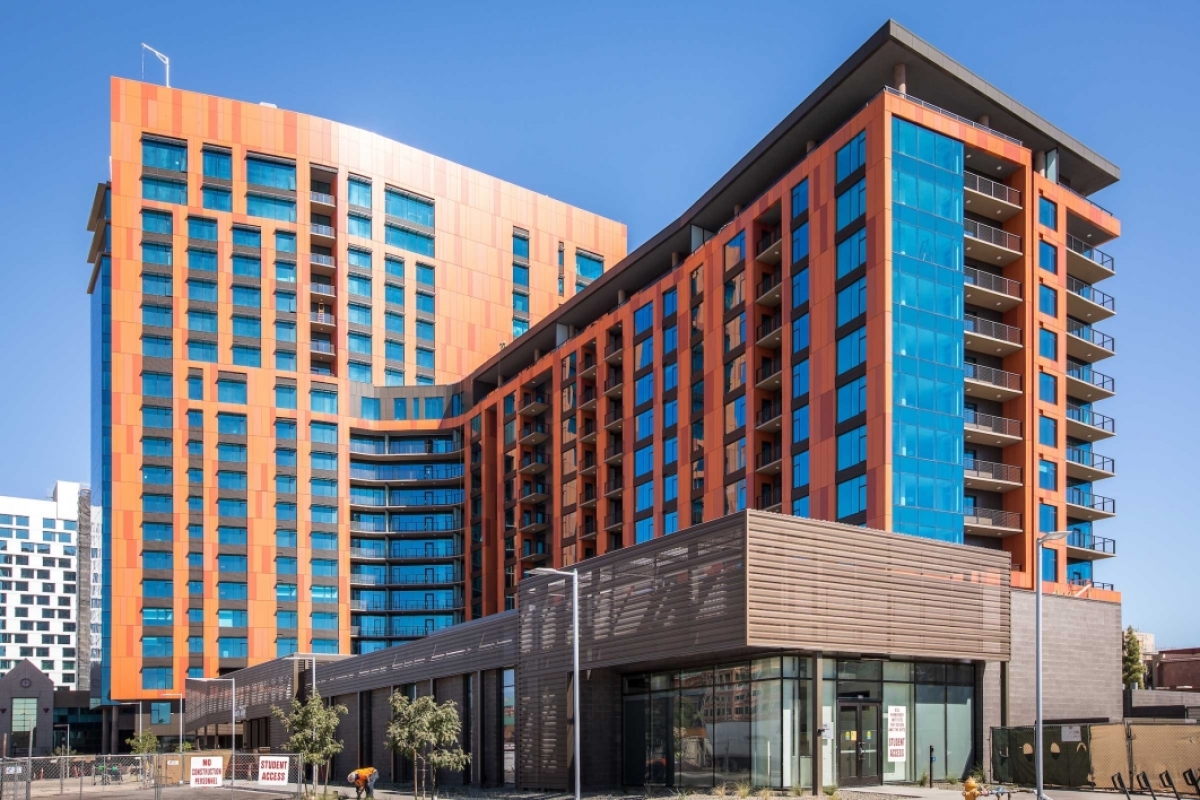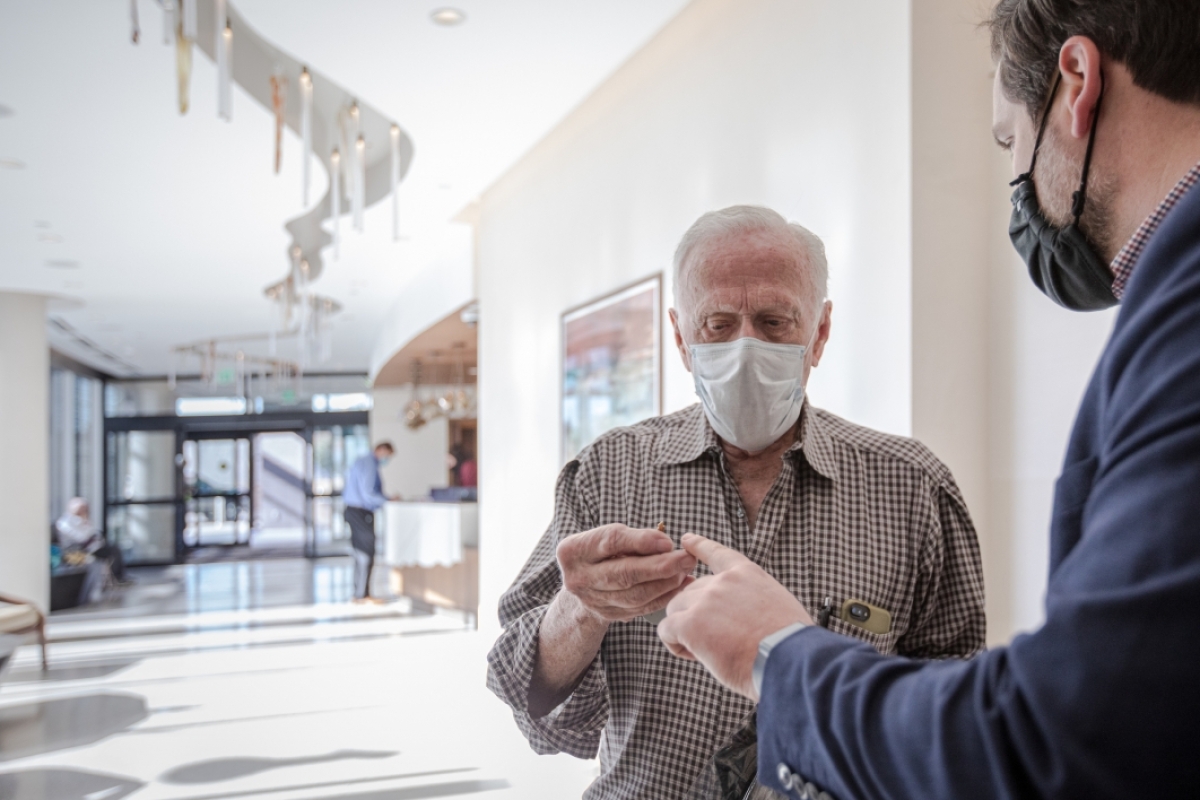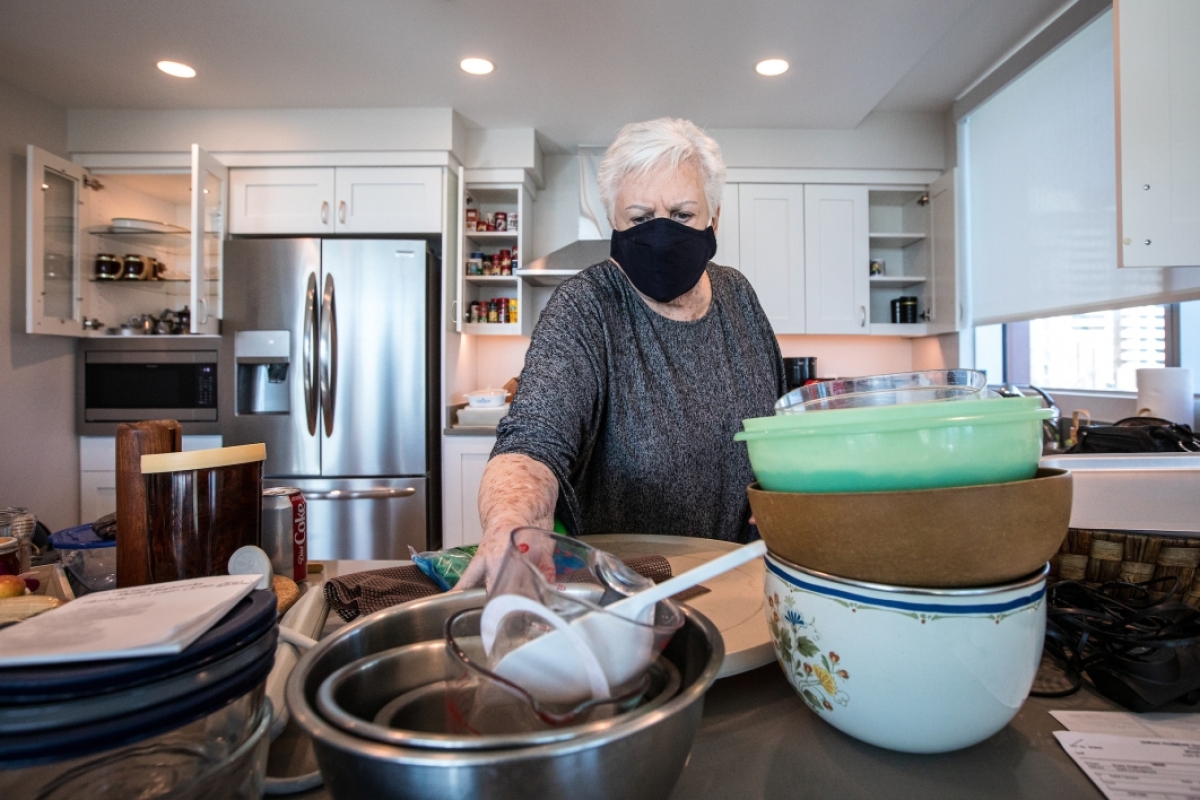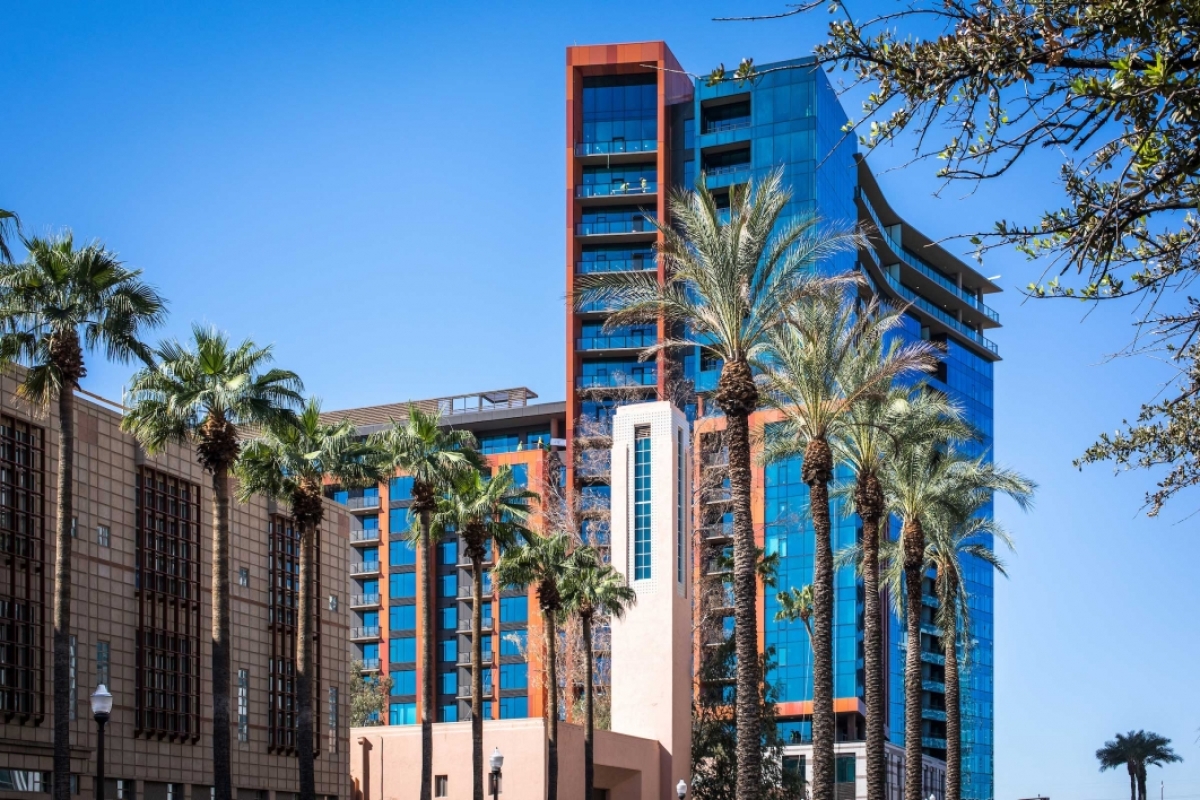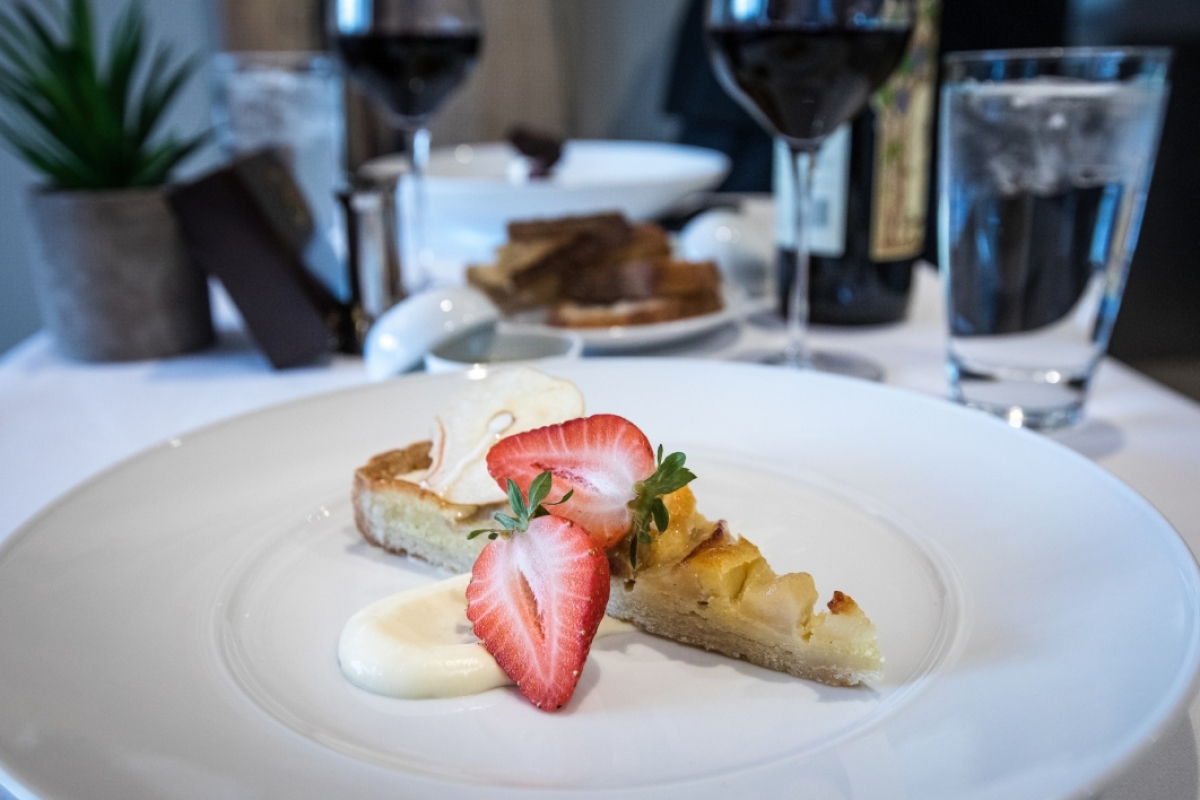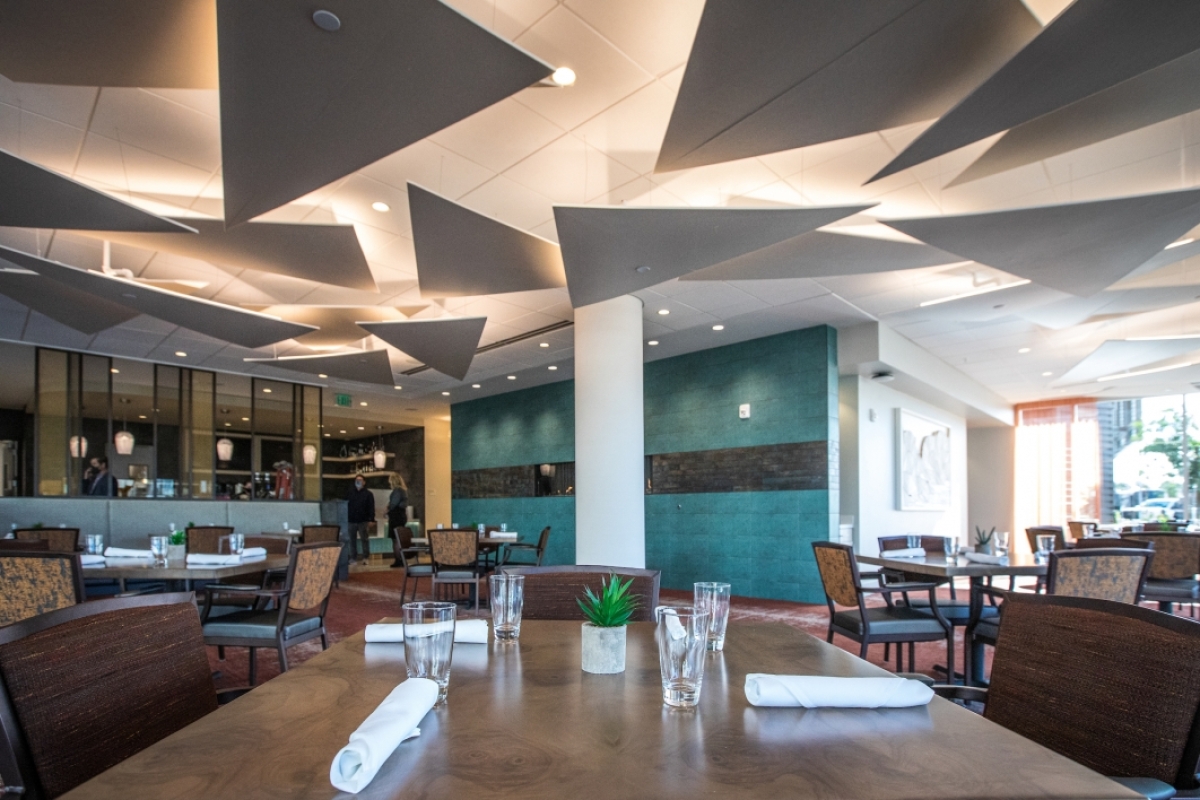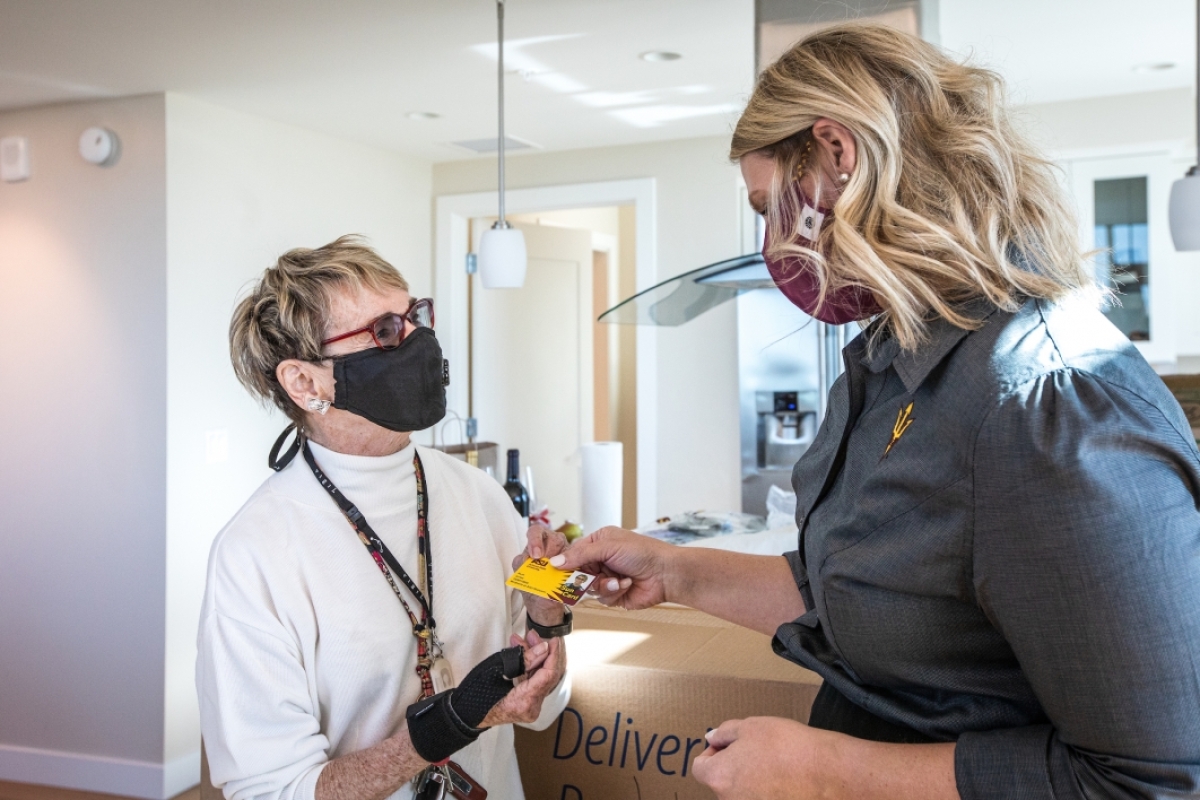Ruth Jones has found her forever home.
It’s 20 stories tall, sits at the edge of the ASU Tempe campus and offers spectacular views of the Valley.
“My forever home had to be someplace, and this is it,” said Jones, a retired political science professor who worked at the university for 35 years. “I chose this place because I wanted to come to a deep, vibrant, exciting place with lots of engagement and activity.”
Jones was one of a handful of residents of varied backgrounds and life experience who moved into Mirabella at ASU, a new $252 million intergenerational living and lifelong learning complex, on Dec. 28. Residents will continue moving into the building — four units a day — through the spring.
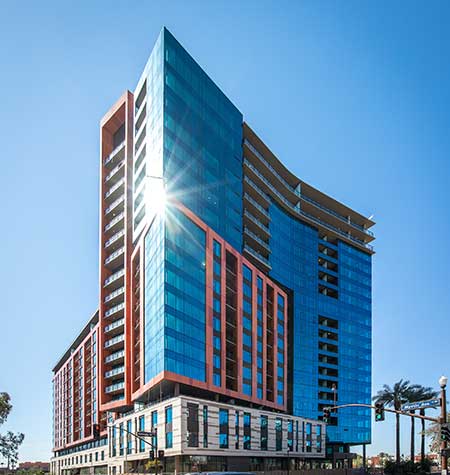
Mirabella at ASU features 239 independent-living apartments and 59 health care units, as well as an array of other amenities. Photo by Charlie Leight/ASU
The new structure at the southeast corner of University Drive and Mill Avenue was developed by private, nonprofit developers University Realty and Pacific Retirement Services on land owned by ASU. It features 239 independent-living apartments and 59 health care units, as well as an indoor pool and wellness center, physical therapy gym, theater, art museum, event and lecture hall, game rooms, salon and spa, dog park, valet and underground parking, and four restaurants, including a ground-floor bistro that will eventually be open to the public.
Mirabella at ASU promises to combine urban sophistication with a rousing university environment for a one-of-a-kind retirement experience. It will also link the university community to the residents, who are age 62 and older, with an average age of 76. They will be able to take classes, have full access to the campus’ amenities, and be near cultural and sports events, while soaking in the desert oasis from the heart of the city.
“ASU wants its students to become master learners, meaning individuals who are capable of learning and adapting throughout their whole lives,” said Lindsey Beagley, who is the lifelong university engagement director at Mirabella at ASU. “Our residents are people who know that learning doesn’t stop after they graduate or they’ve concluded their professional careers. This is an opportunity to integrate master learners into our campus environment, which is a win-win for everyone.”
According to Beagley, Mirabella at ASU residents can join ASU classes as “guest learners” and study alongside ASU students. Instructors have extended invitations to residents to join 117 courses in the spring, and the list is growing. Twenty-three residents have already signed up to attend classes during the spring 2021 semester.
Five years in the making
Perhaps no one is happier to see Mirabella at ASU open than its builder — McCarthy Building Companies Inc. It has been on its drafting table since 2015.
“When you open a building of this size, it’s a great relief and very satisfying. A lot of planning and effort went into Mirabella at ASU,” said Kurt Nyberg, vice president of operations for McCarthy. “Architecturally, it’s a striking building, and it’s now a monument in Tempe.”
Nyberg said the impact goes beyond aesthetics. The building includes sustainable material from the state and region, and 50 percent construction waste reduction. Other environmentally friendly features include electric vehicle charging stations, water-saving fixtures and photovoltaic panels.
The 613,000-square-foot structure took more than a year to construct and employed approximately 500 laborers, according to Nyberg.
“The labor expenditures for putting this building together has been enormous, but it has supported over 500 families with diverse backgrounds for an entire year,” Nyberg said. “Those same workers also ate at nearby restaurants, shopped at Tempe stores and infused money into the local economy.”
The concept also lured Tom Dorough, executive director at Pacific Retirement Services, which co-owns and operates the site and will eventually employ approximately 200 part- and full-time employees. Dorough worked for a major hotel chain for 18 years but said Mirabella at ASU intrigued him.
“When the project was announced in Tempe near the ASU campus, I thought it was a great concept because so often retirement communities talk about how they can change and be innovative. No one could quite put their finger on it,” Dorough said. “With ASU’s involvement, we were able to do some very innovative things. It was so exciting that I said, ‘That’s something I want to be a part of.’”
University-inspired retirement (with plenty of perks)
When 85-year-old Sheila Zieglowsky heard about Mirabella at ASU a few years back, she and her husband, James, loved the concept of being near the university and its enormous library. A retired educator originally from Illinois, Zieglowsky said her two-bedroom, two-bath apartment at Mirabella is 1,450 square feet and has a balcony that offers views of ASU Gammage, Tempe Butte and South Mountain. It’s much different than their large home in the Superstition Mountain Golf & Country Club in Gold Canyon, but they were ready for a new life and a new home. And no yard work.
When James died in February, Sheila said Mirabella at ASU became her new lifeline.
“I needed to get out of that big house and come to where there’s people, excitement, restaurants and shopping,” Zieglowsky said. “I’m also a big reader and now have access to ASU’s library and many classrooms.”
Zieglowsky will have access to much more. In addition to residents' access to ASU Library materials (some 5 million books, plus digital materials, collections, facilities and maker spaces) and classes, Mirabella at ASU will host on-site faculty-led lectures, workshops and book clubs, as well as touring various destinations of interest on campus.
Residents are officially affiliated members of the ASU community with Sun Cards (university ID cards), granting them access to the following benefits:
- Free admission to all ASU Athletics (except men’s football and basketball).
- Free admission to performances by Herberger Institute for Design and the Arts.
- Group rates for ASU’s “Beyond” series and presale access to Broadway performances at ASU Gammage.
- Affiliate discount to the Sun Devil Fitness Complex.
- Discount on ASU merchandise at the bookstores.
- Buses for shopping and errands in a 10-mile radius.
- Complimentary town car service/shuttle for medical, dental, eye appointments and Phoenix Sky Harbor International Airport.
But the best perk for Zieglowsky’s daughter Valerie is knowing her mother will be in good hands.
“We know she’ll be safe and well taken care of at this location,” Valerie Zieglowsky said of the on-location security and health care staff. “We’re thankful that she’s here.”
Connecting the Dotts
Don Dotts was ASU’s alumni director for 26 years and serves on seven local nonprofit boards, including the board of trustees at the Walter Cronkite School of Journalism and Mass Communication. At 85, he has taken on a new job: editor of the “Mirabella at ASU Universe.” The online community newsletter will publish every other month, and Dotts is working on its third edition. He likes the idea of staying busy and being within walking distance of his church and the campus.
“Instead of doing my daily walk around my neighborhood, I’ll be walking around the campus,” said Dotts, who has lived in The Lakes of Tempe for the last 43 years. “I look forward to walking to ASU Gammage and to Sun Devil Stadium. I’m also a block from my church. All of this was appealing to me.”
In 1953, Dotts and his wife were freshmen at the ASU Tempe campus when its student body was 10,000 strong. Now, at 85, he is willing to impart his acquired knowledge to others. Mirbella at ASU residents will have the same opportunity. Approximately 15 percent have signed on the ASU Mentor Network to be student mentors, imparting professional, civic and industry knowledge to students and providing guidance.

Each of Mirabella's 20 floors has a different desert botanical theme, in partnership with the School of Life Sciences at ASU. Mirabella will also offer opportunities to students in arts, nursing, engineering and more. Photo by Charlie Leight/ASU
That’s just one of many partnerships the complex has planned with the university. The location of Mirabella at ASU creates opportunities for academic units and student experiential learning. Others include:
- Herberger Institute for Design and the Arts: Three students from ASU’s School of Music, Dance and Theatre will be selected to live in the building as artists-in-residence in exchange for performing five to six nights a week or creating music programming.
- Edson College of Nursing and Health Innovation: Pre-licensure nursing students can provide valuable health services and gain supervised clinical experience as well as exposure to a potential professional pathway.
- College of Health Solutions: Kinesiology, sports and exercise science student internships will focus on physical activity, sleep, nutrition and stress reduction to enhance all aspects of wellness.
- Ira A. Fulton Colleges of Engineering: Computer science students are to offer residents technical support service.
- Mirabella at ASU will also house 10,000 square feet of gallery and studio space where Herberger Institute students can showcase their art and creative design work alongside residents’ work.
Health at your doorstep
Loyd and Susan Shipman traded an oceanside view in San Luis Obispo, California, for a view of Mill Avenue and University Drive. They have waited three years to move into their two-bedroom, 1,450-square-foot unit. So far they have no regrets.
“There’s so many amenities here, but I especially liked the fact they had a woodworking shop,” said 88-year-old Loyd Shipman, a retired field engineer with AT&T.
Susan Shipman, who worked for the Bank of America for 30 years, said there was another draw for the couple — the health care options Mirabella at ASU offers.
“We’ve had a few surgeries, and it was very hard at our age to recover while looking out after the other,” Susan Shipman said. “We want to continue the life we’re living, but we also don’t want to be a burden to our children.”
As a Life Plan Community, Mirabella at ASU offers every level of health care on-site, from assisted living to memory support, skilled nursing and rehabilitation services. Having this full continuum of care on-site gives the Shipmans great peace of mind.
In the meantime, they plan on living well.
“We’ve saved all of our lives to have a good retirement,” Susan Shipman said. “Today it starts.”
Top photo: Ruth Jones moves into her two-bedroom, two-bath unit at the new Mirabella at ASU, on Dec. 28, the first day residents could move into their new residences. The 20-story senior-living facility residents can take university classes, have access to the libraries and are close to cultural and sporting events. Mirabella will offer opportunities to students from Herberger Institute for Design and the Arts, College of Health Solutions and the Edson College of Nursing and Health Innovation. Photo by Charlie Leight/ASU
More Health and medicine

The science of sibling dynamics: Why we fight, how we relate and why it matters
We have Mother’s Day, Father’s Day and even Grandparents’ Day. But siblings? Usually they get a hand-me-down sweatshirt and, with any luck, a lifetime of inside jokes.But actually, there is a…

New study seeks to combat national kidney shortage, improve availability for organ transplants
Chronic kidney disease affects one in seven adults in the United States. For two in 1,000 Americans, this disease will advance to kidney failure.End-stage renal failure has two primary…

New initiative aims to make nursing degrees more accessible
Isabella Koklys is graduating in December, so she won’t be one of the students using the Edson College of Nursing and Health Innovation's mobile simulation unit that was launched Wednesday at Arizona…


